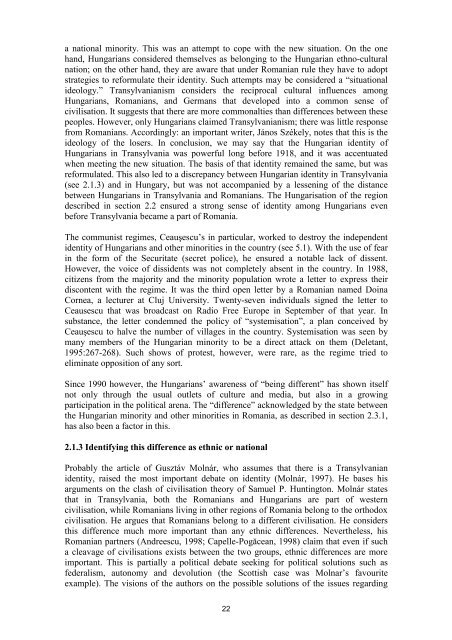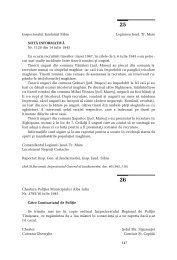Southeast Europe
Southeast Europe
Southeast Europe
Create successful ePaper yourself
Turn your PDF publications into a flip-book with our unique Google optimized e-Paper software.
a national minority. This was an attempt to cope with the new situation. On the one<br />
hand, Hungarians considered themselves as belonging to the Hungarian ethno-cultural<br />
nation; on the other hand, they are aware that under Romanian rule they have to adopt<br />
strategies to reformulate their identity. Such attempts may be considered a “situational<br />
ideology.” Transylvanianism considers the reciprocal cultural influences among<br />
Hungarians, Romanians, and Germans that developed into a common sense of<br />
civilisation. It suggests that there are more commonalties than differences between these<br />
peoples. However, only Hungarians claimed Transylvanianism; there was little response<br />
from Romanians. Accordingly: an important writer, János Székely, notes that this is the<br />
ideology of the losers. In conclusion, we may say that the Hungarian identity of<br />
Hungarians in Transylvania was powerful long before 1918, and it was accentuated<br />
when meeting the new situation. The basis of that identity remained the same, but was<br />
reformulated. This also led to a discrepancy between Hungarian identity in Transylvania<br />
(see 2.1.3) and in Hungary, but was not accompanied by a lessening of the distance<br />
between Hungarians in Transylvania and Romanians. The Hungarisation of the region<br />
described in section 2.2 ensured a strong sense of identity among Hungarians even<br />
before Transylvania became a part of Romania.<br />
The communist regimes, Ceauşescu’s in particular, worked to destroy the independent<br />
identity of Hungarians and other minorities in the country (see 5.1). With the use of fear<br />
in the form of the Securitate (secret police), he ensured a notable lack of dissent.<br />
However, the voice of dissidents was not completely absent in the country. In 1988,<br />
citizens from the majority and the minority population wrote a letter to express their<br />
discontent with the regime. It was the third open letter by a Romanian named Doina<br />
Cornea, a lecturer at Cluj University. Twenty-seven individuals signed the letter to<br />
Ceausescu that was broadcast on Radio Free <strong>Europe</strong> in September of that year. In<br />
substance, the letter condemned the policy of “systemisation”, a plan conceived by<br />
Ceauşescu to halve the number of villages in the country. Systemisation was seen by<br />
many members of the Hungarian minority to be a direct attack on them (Deletant,<br />
1995:267-268). Such shows of protest, however, were rare, as the regime tried to<br />
eliminate opposition of any sort.<br />
Since 1990 however, the Hungarians’ awareness of “being different” has shown itself<br />
not only through the usual outlets of culture and media, but also in a growing<br />
participation in the political arena. The “difference” acknowledged by the state between<br />
the Hungarian minority and other minorities in Romania, as described in section 2.3.1,<br />
has also been a factor in this.<br />
2.1.3 Identifying this difference as ethnic or national<br />
Probably the article of Gusztáv Molnár, who assumes that there is a Transylvanian<br />
identity, raised the most important debate on identity (Molnár, 1997). He bases his<br />
arguments on the clash of civilisation theory of Samuel P. Huntington. Molnár states<br />
that in Transylvania, both the Romanians and Hungarians are part of western<br />
civilisation, while Romanians living in other regions of Romania belong to the orthodox<br />
civilisation. He argues that Romanians belong to a different civilisation. He considers<br />
this difference much more important than any ethnic differences. Nevertheless, his<br />
Romanian partners (Andreescu, 1998; Capelle-Pogăcean, 1998) claim that even if such<br />
a cleavage of civilisations exists between the two groups, ethnic differences are more<br />
important. This is partially a political debate seeking for political solutions such as<br />
federalism, autonomy and devolution (the Scottish case was Molnar’s favourite<br />
example). The visions of the authors on the possible solutions of the issues regarding<br />
22









